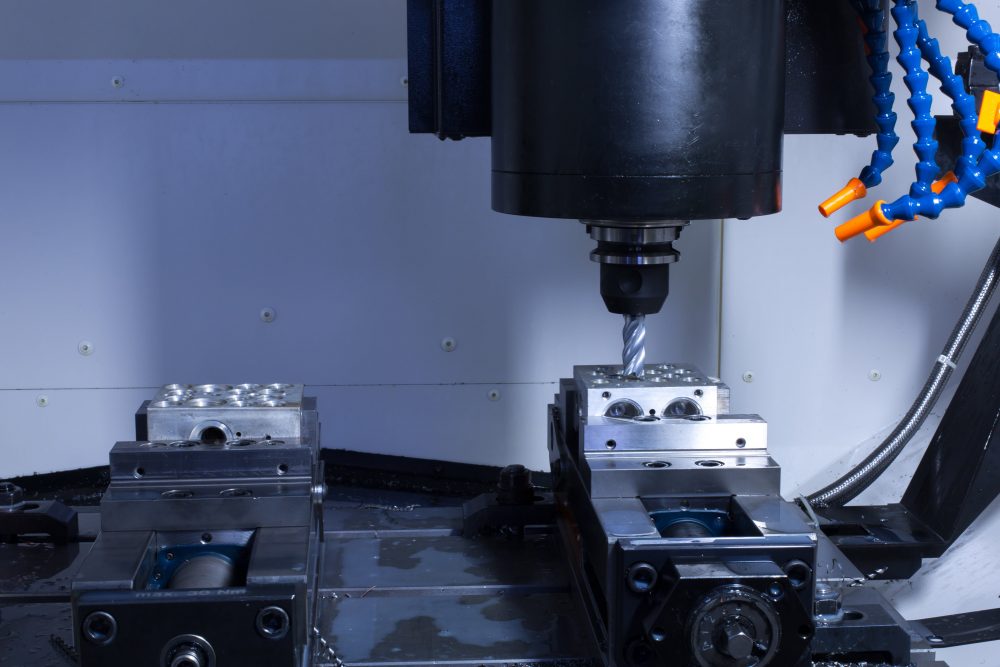CNC milling is a technology developed for production and manufacturing industries. Richard Kegg created the first CNC machine named “Cincinnati Milacron Hydrotel” in 1952, and after five years in 1958, this technology was launched commercially.
Table of Contents
What is CNC milling?
Computer numerical control (CNC) milling is a typical machining process used to produce complex parts. This fabrication method gives high precision customized workpiece and cuts various materials like glass, plastic, metals and wood.
Types of CNC milling machines
Depending on the material type and product manufactured, machines running on CNC technology are categorized into various types like:
Horizontal Milling
In horizontal milling, a mounted CNC cutting tool with a spindle is oriented horizontally, pressed along the workpiece. This machine is ideal for handling heavier and deeper cuts.
Vertical milling
In vertical milling, the spindle is oriented vertically, which moves a rotating cutting tool for removing material from a stationary workpiece. Vertical milling machines are easy to program, and they have diverse capabilities like high tool cutting efficiency, stable performance and rigidity.
Multi-axis milling
In multi-axis milling, the machine usually moves on X, Y and Z-axis and the rotation on the A and B axes. These machines facilitate complex machine operations with high precision.
Milling machine components
The main components of milling machines are:
Column and base
Column and base are the essential castings that assist all other milling machines’ components.
Knee
Knee is a casting which supports the table and saddle components, and all gearing mechanisms conform with it.
Saddle
Saddle is located between the knee and table, and it serves as a transitional part between them.
Table
Table holds the workpiece during the milling process and situated over the knee.
Spindle
The spindle is a component which is used to hold and drive the cutting tools and gives a rotary motion to cutters and arbours on the machine.
Over arm
This component is used to tighten the arbour and cutter support, and it consists of cylindrical bars which slide with the help of holes in the column.
Milling head
Milling head comprises the driving motor, spindle and other controlling mechanisms and it is located at the upper side of a vertical mill machine.
Ram
It is an overarm in the vertical milling machine which supports the spindle and is adjustable to give various positions in the milling process.
Types of axes
The number of the axis on the Computer Numerical Control milling machine influences the level of detail it can cut, type of work it can do and locations of the workpiece it can shape. The various types of the axis in the milling machines which runs on CNC automation are:
3-Axis
In 3-axis machines, the cutting tool moves along the XYZ axis and trims the material while keeping the workpiece stagnant. It is ideal for the parts which do not involve much detailing and depth. 3-Axis machining is used in producing mechanical components and is appropriate for drilling holes, milling slots and interactive operation.
4-Axis
In 4-axis machining, the workpiece remains in the same position as in the 3-axis machining, but it has an added rotary movement on X-axis or A Axis. The rotary motion assists the workpiece in cutting on the B axis.
4-axis machining is advantageous when you need a cut or hole on the side of the workpiece, and it is appropriate for continuous cutting, intermittent cutting and engraving curved surface.
5-Axis
In a 5-axis machine, the workpiece is manipulated automatically from five sides at a time. 5-axis machines can operate on any two sides of the three rotational axes (A, B, C) in addition to mechanical movements on X, Y and Z-axis.
5-axis machining is favourable for making complex shapes which are solid and mostly used in the automotive, aerospace, medical and energy industry.
Materials used
Once you decide to use CNC machinery for manufacturing your product, you can choose the perfect material that suits your requirements. The various kind of materials that are suitable for CNC machines are:
- Metals like aluminum, steel, titanium, copper, brass, zinc, bronze, magnesium,
- Plastics like PVC, Nylon and Peek.
- Other materials like wood, fiberglass, foam.
CNC milling process
Milling machines that run on CNC technology use computerized programming codes to operate the machine tools used to cut and shape the materials. The stages which are followed by all CNC machining processes include:
- Designing the parts in the CAD model.
- Converting the CAD files into the CNC program for machining.
- Setting up the machine
- Execute producing the parts.
Final words
The information given above are the basics of the CNC milling. This technology has transformed industrial manufacturing tremendously from the past few decades. The future of this automated machinery is very bright despite the changes in industrial science because it has an incredible success rate.
The article is a part of our comprehensive guide on CNC machines.



